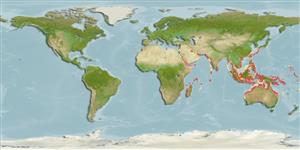Environment: milieu / climate zone / depth range / distribution range
Ecología
marino; agua dulce; salobre bentopelágico; anfidromo (Ref. 51243); rango de profundidad 0 - 30 m (Ref. 43448). Tropical; 30°N - 26°S
Indo-West Pacific: northern Indian Ocean and the Indo-Australian Archipelago. A lessepsian migrant, now prevalent in the Mediterranean (Ref. 43448).
Tamaño / Peso / Age
Maturity: Lm ? range ? - ? cm
Max length : 30.0 cm TL macho / no sexado; (Ref. 58652)
Espinas dorsales (total): 11 - 12; Radios blandos dorsales (total): 9-11; Espinas anales 3; Radios blandos anales: 8 - 9
Adults inhabit coastal waters, entering brackish estuaries (Ref. 3132) and mangrove areas (Ref. 7300). Also in fresh waters (Ref. 30573). Feed on fishes and invertebrates. Eggs are guarded and fanned by the male parent (Ref. 205).
Life cycle and mating behavior
Madurez | Reproducción | Puesta | Huevos | Fecundidad | Larva
Eggs are guarded and fanned by the male parent (Ref. 205).
Paxton, J.R., D.F. Hoese, G.R. Allen and J.E. Hanley, 1989. Pisces. Petromyzontidae to Carangidae. Zoological Catalogue of Australia, Vol. 7. Australian Government Publishing Service, Canberra, 665 p. (Ref. 7300)
IUCN Red List Status (Ref. 130435)
Threat to humans
Harmless
Human uses
Pesquerías: escaso valor comercial
Herramientas
Special reports
Download XML
Fuentes de Internet
Estimates based on models
Preferred temperature (Ref.
123201): 24.8 - 29.3, mean 28.5 °C (based on 3744 cells).
Phylogenetic diversity index (Ref.
82804): PD
50 = 0.6250 [Uniqueness, from 0.5 = low to 2.0 = high].
Bayesian length-weight: a=0.00479 (0.00188 - 0.01218), b=3.09 (2.87 - 3.31), in cm total length, based on LWR estimates for this (Sub)family-body shape (Ref.
93245).
Nivel trófico (Ref.
69278): 3.4 ±0.47 se; based on food items.
Resiliencia (Ref.
120179): Medio, población duplicada en un tiempo mínimo de 1.4-4.4 años (Preliminary K or Fecundity.).
Fishing Vulnerability (Ref.
59153): Low vulnerability (20 of 100).
Nutrients (Ref.
124155): Calcium = 224 [135, 392] mg/100g; Iron = 1.08 [0.66, 1.73] mg/100g; Protein = 17.3 [16.5, 18.2] %; Omega3 = 0.163 [0.080, 0.322] g/100g; Selenium = 47.6 [23.2, 101.8] μg/100g; VitaminA = 35.1 [14.5, 82.5] μg/100g; Zinc = 2.22 [1.56, 3.01] mg/100g (wet weight);
